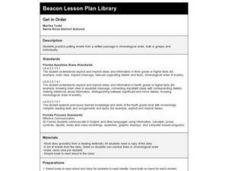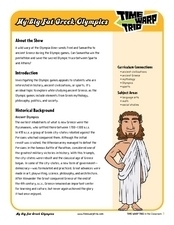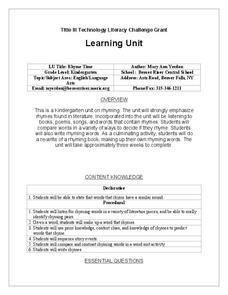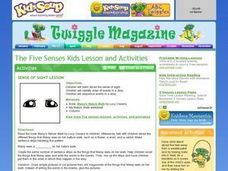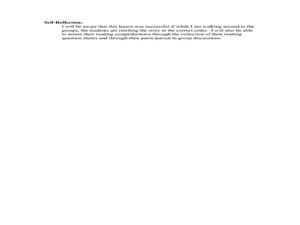Curated OER
Get in Order
Students practice putting events from a written passage in chronological order, both in groups and individually.
AtoZ Teacher Stuff
Pumpkin Life Cycle
From seed to jack-o-lantern, young scholars walk step-by-step through the life cycle of pumpkins with this fun art and science activity. After first participating in a shared reading of the children's book Pumpkin, Pumpkin children color...
Curated OER
Comprehension: Create a Summary from an Expository Text
Children can learn to analyze expository or informational texts at nearly any age. This scaffolded and scripted resource provides teachers with the support needed to facilitate a thoughtful lesson on summarizing informational text by...
Curated OER
Something From Nothing
Students listen to story Joseph Had A Little Overcoat to explore people from another culture and how one item can be used to make other items; students use scraps of fabric and other knickknacks to create pictures or toys.
Curated OER
Language Arts: Plotting Stories
Second graders read the story, "The Foolish, Timid Rabbit," as part of a unit on appearances. After reading with partners, they write their own stories that include elements about some forms of matter from their science studies. Students...
Curated OER
The Faithful Friend
Students work in co-op groups to create a Reader's Theater production of the story. Students create a flow map that sequences the major events in the story. Students research the island of Martinique and create a travel brochure...
Curated OER
Civil Rights Video Essay
Students investigate a decade of American history when the civil rights movement was a focus of national attention. They create a video essay about a person or event that played an important role in shaping the civil rights movement.
Curated OER
A Photo Essay
Students explain the purpose of a photo essay, sequence a series of events, and explain the format in creating a photo essay, which includes a caption for each picture. They complete a photo essay as a creative activity.
Curated OER
Maus: Making a Visual Representation
How do you represent a tragic event? Are stories of tragic events better left untold? After reading chapter two of Maus and studying other representations of the Holocaust (suggestions are included), class members create a representation...
For the Teachers
Cause and Effect Matrix
Study cause and effect in both literature and informational text with a lesson designed for several different reading levels. After kids review the concept of cause and effect, they read an article or story and note the causes and...
Museum of Tolerance
Artifact Research Activity
Artifacts give us the privilege of learning about the past, may it be family, culture, or traditions. Here, class members learn about their family's past with the help of an artifact, or family heirloom. Once an artifact is discovered,...
K5 Learning
Making Cookies
What kind of cookies is Greg making? Can class members identify the order in which each ingredient is added? After reading a brief passage, pupils respond to four short answer comprehension questions.
Time Warp Trio
My Big Fat Greek Olympics
The Olympic Games are indeed a significant and far-reaching cultural component in our international community today, but from where do they originate? Where do our traditions stem from, and how do we choose the sports that constitute...
Curated OER
Penguin Writing
After discussing the main events in Mr. Popper’s Penguins, young writers describe in sequence what they would do if they had 12 penguins living in their house. The narratives are then glued onto a penguin cut-out, mounted on construction...
Curated OER
Multiple Viewpoints (Three Little Pigs)
Your youngsters have probably read The Three Little Pigs, but have they read The Three Little Wolves and the Big Bad Pig? Have your learners brainstorm how the second book could be similar or different from the first. Encourage your...
Curated OER
Story Sequence - Wrapping a Present
In this sequence of events instructional activity, students number the four pictures in order from one to four to illustrate the sequence of wrapping a present.
Curated OER
Which Way???
In this ordering events in a story learning exercise, students read the story and number the sentences in the correct sequence. Students fill in 6 blanks.
Curated OER
Rhyme Time
Students listen to a variety of stories and identify rhyming words. They sequence events in the story and generate rhymes of their own. They sort words by rhyming families and write rhymes of their own.
Curated OER
What Happened Next?
Fifth graders read one short story on their own. After reading, they are given a series of sentences and events from the short story and put them into the correct sequence. To end the lesson, they draw pictures from the story and...
Curated OER
Sense of Sight Lesson
Students sequence what they saw in the book Maisy's Nature Walk. In this sequencing lesson plan, the teacher reads the book and the children listen and observe. Once the book is read, the students have to sequence what Maisy saw on her...
Curated OER
Nibble, Nibble, Little Mouse
Students complete activities to analyze points of view in different texts. In this point of view lesson, students read Hansel and Gretel and The Magic Circle and discuss the points of view. Students choose a character from the story and...
Curated OER
Zoom! Zoom! Zoom! I'm Off to the Moon Sequencing Lesson
Students practice sequencing. In this sequencing lesson, students listen to the book Zoom! Zoom! Zoom! I'm Off to the Moon. They put the story events in sequential order using a graphic organizer.
Curated OER
There Was an Old Lady Who Swallowed a Fly
Fourth graders examine the new vocabulary associated with the book, There Was an Old Lady Who Swallowed a Fly before listening to a teacher read aloud of the book. They complete a choral reading of the story, sequence it, and write...
Curated OER
The Little Hungry Caterpillar
Students discuss "The Little Hungry Caterpillar." In this reading comprehension lesson plan, students make sock caterpillars used in retelling the story so as sequence the events accurately.


